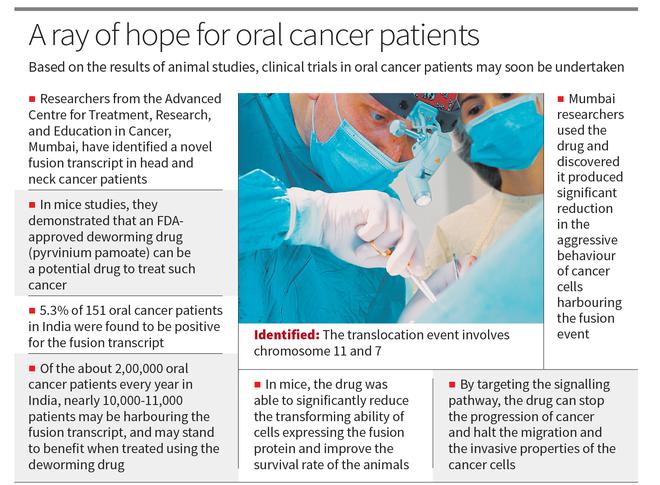A study by Mumbai-based researchers has successfully identified a novel fusion transcript in head and neck cancer patients. Not only did the researchers find the fusion transcript to be a promising therapeutic target for head and neck cancer but also found that an FDA-approved deworming drug called pyrvinium pamoate can be a potential drug to treat such cancer. The results were published in the journal NPJ Precision Oncology.
Fusion transcript arises when small segments of two chromosomes exchange their positions leading to structural rearrangement of the chromosomes. For instance, a translocation involving chromosomes 6 and 18 will result in chromosome 6 having a small segment of chromosome 18, while chromosome 18 will have a small segment of chromosome 6. As a result of the segment exchange between two chromosomes, two different genes are brought together at the point where the segments meet leading to the emergence of a chimeric gene or fusion transcript. In this case, researchers from the Advanced Centre for Treatment, Research, and Education in Cancer (ACTREC), Mumbai were able to identify the fusion transcript (UBE3C-LRP5) as well as map the translocation event to single-base resolution. The translocation event involves chromosome 11 and 7.
The team led by Dr. Amit Dutt, who is currently a Professor at the Department of Genetics at the University of Delhi South Campus, screened 151 oral cancer patients from India using whole transcriptome sequencing and RT-PCR analysis and found 5.3% of patients were positive for the fusion transcript. The team also found the fusion transcript in 1.2% of Caucasian patients; samples of 502 Caucasian patients from the Cancer Atlas were studied. Oral cancer is the most predominant form of cancer among Indian patients with about 2,00,000 new cases being reported every year. “Of them, nearly 10,000-11,000 patients each year may be harbouring the particular fusion transcript (UBE3C-LRP5),” says Dr. Sudhir Nair, an oral cancer surgeon at ACTREC and a co author of the paper. “This prevalence suggests a potentially critical role for the UBE3C-LRP5 fusion in head and neck cancer development, marking a significant breakthrough in our understanding of the disease.”

The researchers demonstrated that the UBE3C-LRP5 fusion activates a particular signalling pathway (Wnt/beta-catenin) which is well known for its role in promoting cancer cell growth, migration and invasion. Dr. Bhasker Dharavath, who is the first author of the paper, found the FDA-approved pyrvinium pamoate drug used for deworming can target the signalling pathway activated by the fusion transcript. Laboratory studies and animal models did confirm the ability of the drug to significantly reduce the aggressive behaviour of cancer cells harbouring the fusion transcript, says Dr. Dutt.
The team first carried out genetic studies. By knocking down different genes of the signalling pathway, the ACTREC team was able to block the activating effects of the fusion transcript. This helped in establishing the essential role of the pathway downstream to the fusion transcript, says Dr. Dutt. Studies carried out by other researchers had shown that the pyrvinium pamoate drug targets the particular signalling pathway that gets altered by the fusion event. Based on this information, the Mumbai researchers used the drug in biochemical and cell-based assays and found the drug to produce significant reduction in the aggressive behaviour of cancer cells harbouring the fusion event.
Silencing key components of this pathway within the cancer cells also led to reduced proliferation, colony formation ability, and interestingly, a decreased response to pyrvinium pamoate treatment. “This finding highlights the potential effectiveness of targeting the pathway to treat cancers driven by the UBE3C-LRP5 fusion,” Dr. Dutta says. The drug was then tested in animal models. In mice, cells overexpressing the fusion transcript and treated with the drug were compared with cells without the fusion transcript. Dr. Ashwin Butle, who is currently a faculty at AIIMS, Nagpur, showed that mice with tumours formed from cells overexpressing the fusion protein showed improved survival when treated with pyrvinium pamoate.
“The drug was able to significantly reduce the transforming ability of cells expressing the fusion protein and improve the survival rate in mice carrying the fusion-overexpressing cells,” Dr. Dutt says. “Drugs that target the pathway can stop the progression of cancer and also halt the migration of cancer cells and their invasive properties.” The fusion mRNA is unique to cancer cells and can be used for cancers of any organ.
“Our study suggests that the UBE3C-LRP5 fusion is a promising therapeutic target for head and neck cancer and that pyrvinium pamoate may be a potential drug candidate for treating head and neck cancer harbouring this translocation,” they write.
With promising results from animal studies, the team is planning to soon undertake clinical trials in oral cancer patients. “Since we will be using an FDA-approved drug whose safety profile is well established, we don’t foresee any health concerns while conducting the clinical trials,” he says.







